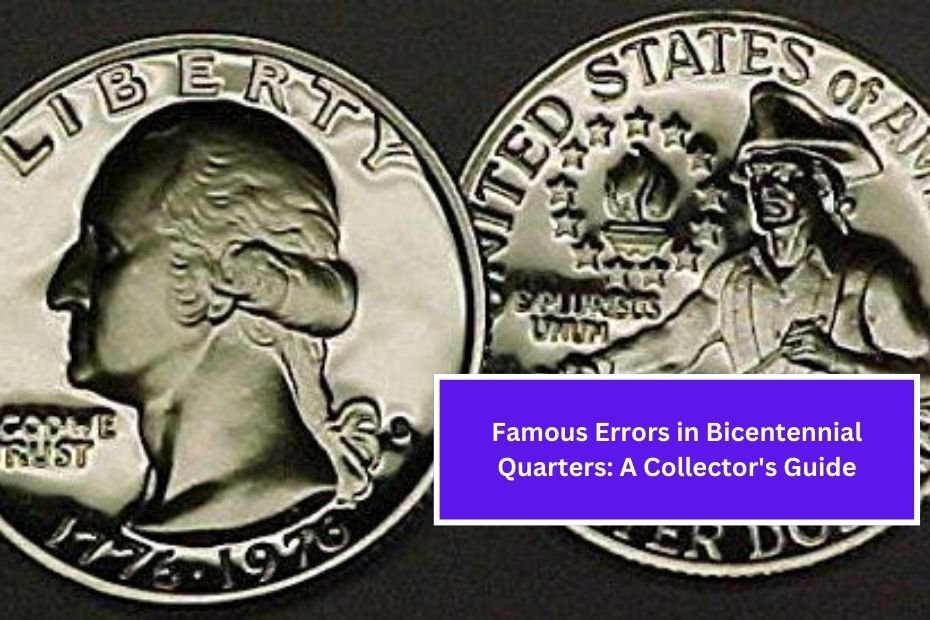The Bicentennial Quarter is a unique piece of American currency that was released in 1975 and 1976 to celebrate the 200th anniversary of the United States. These quarters are special not just for their historical significance but also because some of them have rare errors that make them highly sought after by collectors. In this guide, we will explore the most famous errors in Bicentennial Quarters, their significance, and how you can start your collection.
What are Bicentennial Quarters?
The Bicentennial Quarter features a unique design. The front, or obverse, shows the profile of George Washington, just like the traditional quarter. However, the reverse side (the back) has a special design that includes a depiction of a drummer and the dates “1776” and “1976.” This design was created to commemorate the 200th anniversary of the Declaration of Independence.
Why Were They Made?
The U.S. Mint produced the Bicentennial Quarters to celebrate America’s 200 years of independence. They were issued in large quantities, and for the first time, quarters were minted with the same design for two years. This was a significant event, and many people were eager to collect them, leading to a surge in interest among coin collectors.
The Importance of Coin Errors
Coin errors occur during the minting process. These mistakes can make a coin unique and often increase its value among collectors. For the Bicentennial Quarters, several errors were made, and some of these are particularly famous. Collectors love to find these errors because they can be rare and valuable.
Famous Errors in Bicentennial Quarters
1. The Double Die Error
One of the most well-known errors is the double die error. This happens when a coin is struck twice by the die, resulting in a blurred or doubled image. Some Bicentennial Quarters exhibit this error, particularly on the date or the lettering on the coin. The most famous example is the 1976 Bicentennial Quarter that shows a noticeable doubling in the “LIBERTY” and the date.
Value: A double die error can be worth hundreds of dollars, depending on its condition.
2. The Clipped Planchet Error
Another fascinating error is the clipped planchet. This occurs when the metal blank used to make the coin is improperly cut, resulting in a quarter that is missing a piece. Some Bicentennial Quarters have been found with a portion of the coin missing from the edge. This creates a unique shape that is easily identifiable.
Value: Clipped planchet errors can also fetch a high price, often ranging from $50 to several hundred dollars, depending on how much of the coin is missing.
3. The Off-Center Strike
An off-center strike happens when the coin is not properly aligned during the minting process. This results in the design being shifted to one side, leaving blank space on the opposite side. Some Bicentennial Quarters have been found with off-center strikes, making them an exciting find for collectors.
Value: Off-center errors can vary widely in value, from $20 to over $300, depending on how far off-center the strike is.
4. The Wrong Planchet Error
A rare and intriguing error is the wrong planchet error. This occurs when a coin is struck on a planchet intended for a different denomination. For instance, if a Bicentennial Quarter was mistakenly struck on a nickel planchet, it would result in a smaller and lighter coin. These errors are incredibly rare.
Value: The value of a wrong planchet error can be substantial, often reaching several thousand dollars.
5. The Surface Errors
Surface errors can include various issues like scratches, dents, or even bubbles on the coin’s surface. While not all surface errors are considered collectible, some unique examples can attract collectors’ attention, especially if they are distinct and rare.
Value: Surface errors can be worth anywhere from a few dollars to several hundred, depending on the rarity and significance of the error.
How to Identify Errors
Identifying errors in Bicentennial Quarters can be a fun and rewarding experience. Here are some tips to help you spot potential errors:
- Use Magnification: A good magnifying glass or jeweler’s loupe can help you see small details that might indicate an error.
- Compare with Known Examples: Familiarize yourself with examples of known errors. Look at images online or visit coin shows to see them in person.
- Check for Clarity: Errors often result in blurring or doubling of text and images. Look closely at the lettering and designs for any irregularities.
- Feel for Unusual Shapes: If the quarter feels different, like being uneven or having a strange edge, it might be an error coin.
- Consult Experts: If you believe you have found a rare error, consider taking it to a professional coin dealer or a numismatist for verification.
Starting Your Collection
If you’re interested in collecting Bicentennial Quarters, here are some steps to get started:
1. Educate Yourself
Read books, join online forums, and follow collector websites to learn more about coins and errors. The more you know, the better you can identify valuable coins.
2. Set a Budget
Decide how much you are willing to spend on your collection. Errors can vary greatly in price, so it’s essential to set a budget.
3. Visit Coin Shows and Shops
Attend local coin shows, fairs, and shops. This is a great way to find Bicentennial Quarters and meet other collectors. You can learn a lot by speaking with experienced collectors and dealers.
4. Use Online Marketplaces
Websites like eBay and specialized coin marketplaces can be good places to find Bicentennial Quarters, especially error coins. Be cautious and ensure that you are buying from reputable sellers.
5. Keep Your Coins Safe
Once you start collecting, make sure to store your coins properly. Use protective coin holders or albums to prevent scratches and damage. Avoid cleaning your coins, as this can decrease their value.
Conclusion
Bicentennial Quarters are a fascinating part of American numismatic history. With their unique designs and various error coins, they offer an exciting opportunity for collectors. Whether you’re a beginner or an experienced collector, learning about these famous errors can enhance your appreciation for this quarter and the world of coin collecting.
By keeping an eye out for errors and educating yourself, you can build a valuable and interesting collection. Happy collecting!

